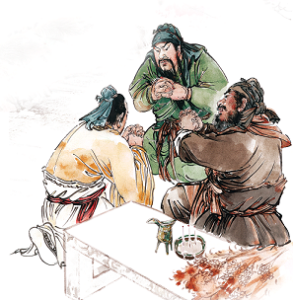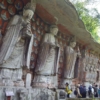History of Chongqing Part 1
B.C. & Ancient Times

The history of Chongqing is said to be traced back to 4,000 – 5,000 years ago.
The part 1 will introduce B.C. up to Northern and Southern Dynasties (南北朝).
Please refer to Part 2 for the history after Sui (隋)
In Sichuan (四川) area, the first evidence of human being’s living can be seen back in B.C.200, which is believed to be the start of the Old Stone Age.
The New Stone Age started around B.C.7,000 – B.C.8,000 and more than 200 ruins have been found in Sichuan.
Then Sichuan goes through several ancient eras in B.C.4,000 – B.C.5000.
At the same time, some nations were built in the central part of China and the history goes into Xia (夏)・Shang (商)・ Zhou (周).
Chinese History Chart
Xia (夏): B.C.2100 – B.C.1700
・Shang (商): B.C.1700 – B.C.1100
・Zhou (周): B.C.110 – B.C.221 including Western Zhou (西周)・Eastern Zhou (東周)・Spring&Autumn (春秋)・Warring States (戦国)
・Qin (秦): B.C.221 – B.C.207
・Han (漢): B.C.206 – 220 including Western Han (西漢)・Western Han (東漢)
・Three Kindoms (三国): 220 – 280 consisting of Wei (魏)・Wu (呉)・蜀 (Shu)
・Jin (晋): 266 – 420 including Western Jin (西晋)・Western (東晋)・Sixteen Kingdoms (五胡十六国)
・Northern and Southern Dynasties (南北朝): 386 – 577 including Song (宋)・Northern Wei (北魏)・Qi (齐)・Liang (梁)・Western Wei (西魏)・Eastern Wei (東魏)・Chen (陈)・Northern Zhou・Northern Qi (北齐)
・Sui (隋): 581 – 619
・Tang (唐): 618 – 907 including Wu Zhou (武周)
・Song (宋): 960 – 1279:Five Dynasties and Ten Kingdoms (五代十国)・Northern Song (北宋)・Liao (辽)・Western Xia (西夏)・Jin (金)・Northern Song(南宋)
・Yuan (元): 1271 – 1368
・Ming (明): 1368 – 1644
・Qing (清): 1636 – 1912
・Republic of China (中華民国): 1912 – 1949
・People’s Republic of China (中華人民共和国): 1949 – Present
Establishment of Ba Kingdom
During Shang (商) and Zhou (周) era, the first nation was established in Sichuan, which was Shu (蜀).
In the place where current Chongqing is located, the first nation, “Ba" (巴) was established in Xia (夏) era.
Ba (巴) is originated from a tribe living in west Hubei are.
Ba tribe made alliance with other tribes and expanded its living area to east part of Sichuan (Chongqing), west part of Henan (湖南) and southeast part of Shanxi (陝西).
There is a legend about the establishment of Ba (巴).
When 5 clans (namely Ba (巴), Fan (樊), Shen (瞫), Xiang (相), and Zheng (鄭)) gather to decide the first king and the name of the nation, a competition was held.
That was to throw a dagger and have it lodge in a stone crevice high up a cliff.
The person who could make it, could be a king.
Among 5 representatives from each clan, a son of the Ba clan was the only successful guy.
However, other competitors were unsatisfied with the result and held another contest.
This time every representative is given one rusting boat and swearing.
Whoever can afloat himself in rough water for the longest time can be a king.
Again, the son of the Ba clan won so he became the first king and named the nation as Ba.
Ba Culture
Fortune-telling and ritual are often used to make important decisions and human sacrifice seems to be practiced in Ba.
In Chongqing, a lot of bronze/rock/borne-made potteries which might be used in those rituals have been found.
In Ba culture, tigers are highly respected, especially white tigers are symbolized as God.
This is based on story that the first king of Ba transformed into a white tiger after passed away.
Also, Ba was famous for its high quality weapons and Ba soldiers were often hired as mercenaries when wars happened in neighboring nations.
In battlefields, Ba soldiers recognized each other by weapons topped with figure of tiger.
In Ba, Bayu (巴渝) dance was created and its interesting feature is to dance with weapons.
Bayu dance was developed further during Tang (唐) era and similar dance styles which could be originated from Bayu are found in Central Asia today.
As unique hieroglyph was utilized for communication, Ba had advanced culture.
Ba culture is well-respected and preserved in Chongqing today.
Qin (秦) to Three Kingdoms Era

Ba was extinct in B.C.316 defeated by Qin (秦).
Zhangyi (张仪) who was born in Wei (魏) and a chancellor of Qin came to Jiangzhou (江州), which is located in Chongqing today, with soldiers and constructed the first castle in that area near Chaotianmen (朝天门).
The name of place as still called “Ba" in Qin era, but it changed its name to “Jiangzhou" (江州) in Han (漢) era and “Jingzhou" (荊州) when it belonged to Shu (蜀) during Three Kingdoms (三国) era
In Chongqing, there is Baidi Castle (白帝城) where Liubi (劉備) from Shu (蜀) passed away.
Baidi Castle was constructed by Gongsunshu (公孫述) in late Han era.
Liubi established Shu in 221 but his brother-in-law, Zhangfei (張飛), was betrayed by his subordinate and died in the same year.
The subordinate ran away and brought Zhangfei’s head to Wu (呉).
In 222, Liubi attacked Wu.
At first Wu suggested to compromise and stop the war but Lubi didn’t listen that, probably because of his personal anger due to Zhanfei’s death.
The war was started between 40,000 soldiers of Shu led by Liubi vs 50,000 soldiers of Wu organized by Luxun (陸遜).
Luxun was unexperienced in real wars at that time so Wu generals didn’t follow his tactics, and then Wu was almost defeated by Shu.
However, one day in midnight, Luxun led several boats silently and shut tons of fire-arrows to Shu’s camp base.
Shu was significantly damaged by the night attack and Liubi managed to retreat to Baidi Castle saved by Zhaoyun (趙雲).
In Romance of the Three Kingdoms, Zhuguliang (諸葛亮), a military strategist of Shu, predicted that Shu would be defeated by Wu so he had prepared the way to escape from the battlefields in advance.
Later on Liubi passed away at Baidi Castle in 223.
Shu was destroyed by Wei (魏) in 263.
In 265, Simayan (司馬炎) established Jin (晋) and defeated Wu in 280.
After that, Northern and Southern era (南北朝) came into place and Jingzhou (Chongqing) changed its name again and again as time goes by → Part 2




Discussion
New Comments
No comments yet. Be the first one!